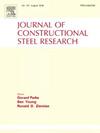Effect of the employed soil constitutive model on the response of large-span soil steel bridges to soil and truck loading
IF 4
2区 工程技术
Q1 CONSTRUCTION & BUILDING TECHNOLOGY
引用次数: 0
Abstract
Current design codes and standards recommend refined analysis methods to accurately predict the behaviour of large-span soil-metal bridges. Consequently, the FE modelling of these structures must employ an appropriate constitutive model for the soil capable of mimicking its performance under various loading conditions. This study investigates the influence of different soil constitutive models on the performance of soil-steel arch bridges with spans up to 32.4 m. A comprehensive analysis was performed using a validated 3D finite element model to evaluate the suitability of three widely adopted soil models: the Mohr-Coulomb (MC) model, the Hardening Soil (HS) model, and the Hardening Soil model with small-strain stiffness (HSs). The results indicate that the choice of soil model significantly affects the predicted structural response. The MC model consistently overestimates the settlement and lateral displacement of the foundations, particularly for larger spans, while underestimating upward deformations of the culvert crown during backfilling. Under traffic loading, the MC model underestimated the outward bending moment at the culvert crown by up to 83 % for smaller spans but showed a reduced discrepancy for larger spans. Overall, the HS and HSs models provided more accurate predictions of the vertical and lateral displacements, bending moments, and thrust forces. The findings underscore the importance of selecting an appropriate soil model in finite element analyses to ensure reliable design and safe performance of soil-steel composite structures.
求助全文
约1分钟内获得全文
求助全文
来源期刊

Journal of Constructional Steel Research
工程技术-工程:土木
CiteScore
7.90
自引率
19.50%
发文量
550
审稿时长
46 days
期刊介绍:
The Journal of Constructional Steel Research provides an international forum for the presentation and discussion of the latest developments in structural steel research and their applications. It is aimed not only at researchers but also at those likely to be most affected by research results, i.e. designers and fabricators. Original papers of a high standard dealing with all aspects of steel research including theoretical and experimental research on elements, assemblages, connection and material properties are considered for publication.
 求助内容:
求助内容: 应助结果提醒方式:
应助结果提醒方式:


